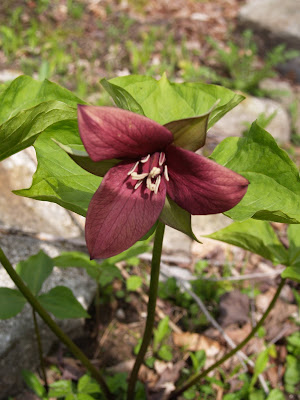 |
| Fiddleheads |
I stopped by the camp this week and was excited to see fiddleheads and Trillium in the woods behind the camp.
 |
| Trillium |
I decided to drive out to Crawford Notch stopping to get gas at Fabyan's. A plump red fox decided to cross the road as I was pumping gas. I didn't have time to grab my camera from the car because she was on the move. I did enjoy watching her as she trotted into the woods behind the gas station.
In Crawford Notch I stopped at the site of the Willey house and recounted the historical landslide that had occured there.
Native Americans used a trail up the Saco River valley through what is now Crawford Notch. During the French and Indian Wars, many English captives were taken to Canada by way of this trail. The obscure Indian trail transformed into the Coös Road, on which was built a small public house in 1793.
The house was abandoned, but in 1825 Samuel Willey, Jr. of Bartlett moved into the small house with his wife, five children, and two hired men. The first year, the men enlarged and improved the house, which the family operated as an inn to accommodate travelers through the mountains on the notch road.
The Willey family had been terrified when they witnessed a landslide on the mountainside across the river from their home. As a result, Mr. Willey built a cave-like shelter a short distance above the house to which the family could flee if such a landslide threatened their side of the valley.
The summer of 1826 started out dry. But on August 26, a powerful storm brought torrential rains to the area, enough to raise the nearby Saco River 24 feet. During previous slides, the Willey family stayed put feeling it was safer in the house. This time, however, the Willey family, along with the two hired men, decided to flee. Instead of running to safety, they ran right into the path of the mudslide. Ironically, the slide split in two around an outcropping of large boulders behind the house. Each half passed on either side of the home and left the house intact. Inside, on the table, was found a Bible, open to the 18th Psalm, Samuel Willey's glasses were on the page.
Mr. and Mrs. Willey, two of the children, and both hired men were found nearby, crushed in the wreckage of the slide. The bodies were buried in Bartlett. Three children and the family dog were never found. If the family had stayed in their home, they would have lived...
Their tragedy inspired "The Ambitious Guest" (1835) by Nathaniel Hawthorne, and Mount Willey was named in their memory. Today, the location is a state historic site.
























